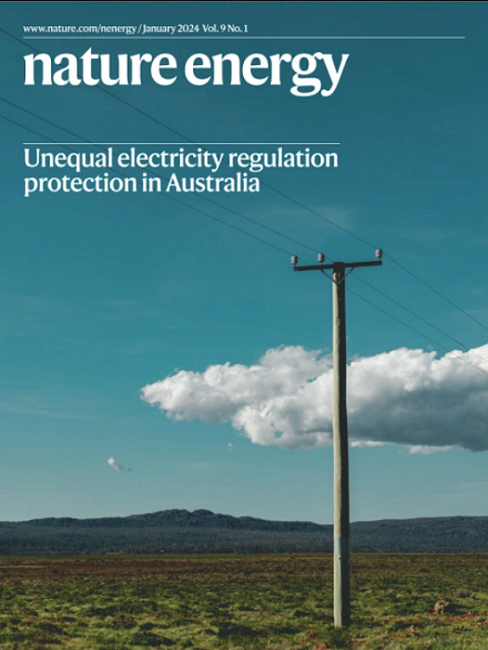Ta–TiOx nanoparticles as radical scavengers to improve the durability of Fe–N–C oxygen reduction catalysts
IF 60.1
1区 材料科学
Q1 ENERGY & FUELS
引用次数: 47
Abstract
Highly active and durable platinum group metal-free catalysts for the oxygen reduction reaction, such as Fe–N–C materials, are needed to lower the cost of proton-exchange membrane fuel cells. However, their durability is impaired by the attack of oxidizing radicals such as ·OH and HO2· that form from incomplete reduction of O2 via H2O2. Here we demonstrate that Ta–TiOx nanoparticle additives protect Fe–N–C catalysts from such degradation via radical scavenging. The 5 nm Ta–TiOx nanoparticles were uniformly synthesized on a Ketjenblack substrate using a high-temperature pulse technique, forming the rutile TaO2 phase. We found that Ta–TiOx nanoparticles suppressed the H2O2 yield by 51% at 0.7 V in an aqueous rotating ring disk electrode test. After an accelerated durability test, a fuel cell prepared with the scavengers showed a current density decay of 3% at 0.9 ViR-free (internal resistance-compensated voltage); a fuel cell without scavengers showed 33% decay. Thus, addition of Ta–TiOx provides an active defence strategy to improve the durability of oxygen reduction reaction catalysts. Low-cost catalysts for oxygen reduction, such as Fe–N–C materials, often suffer from poor stability in fuel cells due to the generation of oxidizing radical species. Here the authors locate Ta–TiOx additives in the vicinity of Fe–N–C catalysts and show that they can successfully scavenge radicals, improving durability.

Ta-TiOx纳米粒子作为自由基清除剂提高Fe-N-C氧还原催化剂的耐久性
为降低质子交换膜燃料电池的成本,需要高活性、高耐久性的无铂族金属氧还原反应催化剂,如 Fe-N-C 材料。然而,这些催化剂的耐久性会受到氧化自由基(如 -OH 和 HO2-)的侵蚀,这些自由基是通过 H2O2 不完全还原 O2 而形成的。我们在此证明,Ta-TiOx 纳米粒子添加剂可通过自由基清除作用保护 Fe-N-C 催化剂免受此类降解。我们采用高温脉冲技术在 Ketjenblack 基底上均匀合成了 5 nm 的 Ta-TiOx 纳米粒子,形成了金红石型 TaO2 相。我们发现,在 0.7 V 的水性旋转环盘电极测试中,Ta-TiOx 纳米粒子可将 H2O2 产率抑制 51%。经过加速耐久性测试后,使用清除剂制备的燃料电池在 0.9 ViR-free(内阻补偿电压)时的电流密度衰减为 3%;而不使用清除剂的燃料电池的电流密度衰减为 33%。因此,添加氧化钽(Ta-TiOx)为提高氧还原反应催化剂的耐久性提供了一种积极的防御策略。用于氧还原反应的低成本催化剂(如 Fe-N-C 材料)在燃料电池中往往由于产生氧化自由基而稳定性较差。在此,作者将 Ta-TiOx 添加剂置于 Fe-N-C 催化剂附近,并证明它们能成功清除自由基,提高耐久性。
本文章由计算机程序翻译,如有差异,请以英文原文为准。
求助全文
约1分钟内获得全文
求助全文
来源期刊

Nature Energy
Energy-Energy Engineering and Power Technology
CiteScore
75.10
自引率
1.10%
发文量
193
期刊介绍:
Nature Energy is a monthly, online-only journal committed to showcasing the most impactful research on energy, covering everything from its generation and distribution to the societal implications of energy technologies and policies.
With a focus on exploring all facets of the ongoing energy discourse, Nature Energy delves into topics such as energy generation, storage, distribution, management, and the societal impacts of energy technologies and policies. Emphasizing studies that push the boundaries of knowledge and contribute to the development of next-generation solutions, the journal serves as a platform for the exchange of ideas among stakeholders at the forefront of the energy sector.
Maintaining the hallmark standards of the Nature brand, Nature Energy boasts a dedicated team of professional editors, a rigorous peer-review process, meticulous copy-editing and production, rapid publication times, and editorial independence.
In addition to original research articles, Nature Energy also publishes a range of content types, including Comments, Perspectives, Reviews, News & Views, Features, and Correspondence, covering a diverse array of disciplines relevant to the field of energy.
 求助内容:
求助内容: 应助结果提醒方式:
应助结果提醒方式:


